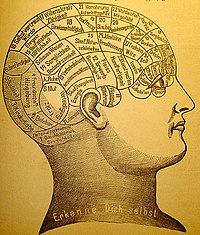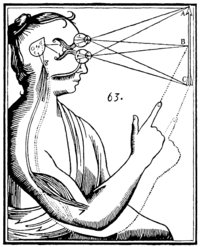ਮਨ
ਦਿੱਖ


ਮਨ ਸੰਗਿਆਨਾਤਮਕ ਸਮਰੱਥਾਵਾਂ ਦਾ ਇੱਕ ਜੁੱਟ ਹੈ ਜੋ ਮਨੁੱਖ ਵਿੱਚ ਚੇਤਨਤਾ, ਦ੍ਰਿਸ਼ਟੀਕੋਣ, ਸੋਚ ਅਤੇ ਕੁਝ ਯਾਦ ਰੱਖਣ ਜਿਹੇ ਗੁਣ ਪੈਦਾ ਕਰਦਾ ਹੈ। ਮਨ ਦੀ ਇਹ ਯੋਗਤਾ ਸਿਰਫ ਮਨੁੱਖਾਂ ਉੱਪਰ ਹੀ ਨਹੀਂ, ਸਗੋਂ ਜਾਨਵਰਾਂ ਉੱਪਰ ਵੀ ਲਾਗੂ ਹੁੰਦੀ ਹੈ।[3][4]
ਵਿਓਂਤਪਤੀ
[ਸੋਧੋ]ਮਨ ਸ਼ਬਦ ਦੇ ਅੰਗਰੇਜ਼ੀ ਰੂਪ mind ਦੀ ਉਤਪੱਤੀ ਤਾਂ ਗ੍ਰੀਕ ਭਾਸ਼ਾ ਜਾਂ ਕਈ ਹੋਰ ਭਾਸ਼ਾਵਾਂ ਦੇ ਸ਼ਬਦਾਂ ਤੋਂ ਮੰਨੀ ਜਾਂਦੀ ਹੈ ਪਰ ਪੰਜਾਬੀ ਸ਼ਬਦ ਮਨ ਦੀ ਉਤਪੱਤੀ ਸੰਸਕ੍ਰਿਤ ਭਾਸ਼ਾ ਦੇ ਸ਼ਬਦ ਮਾਨਸ ਤੋਂ ਹੋਈ ਹੈ। ਪੰਜਾਬੀ ਵਿੱਚ ਹੁਣ ਵੀ ਕਈ ਲੋਕਧਾਰਾਈ ਪ੍ਰ੍ਸੰਗਾਂ ਵਿੱਚ ਲੋਕ ਮਾਨਸ ਸ਼ਬਦ ਆਮ ਵਰਤਿਆ ਜਾਂਦਾ ਹੈ।
ਹਵਾਲੇ
[ਸੋਧੋ]- ↑ Oliver Elbs, Neuro-Esthetics: Mapological foundations and applications (Map 2003), (Munich 2005)
- ↑ Descartes, R. (1641) Meditations on First Philosophy, in The Philosophical Writings of René Descartes, trans. by J. Cottingham, R. Stoothoff and D. Murdoch, Cambridge: Cambridge University Press, 1984, vol. 2, pp. 1-62.
- ↑ Dictionary.com, "mind": "1. (in a human or other conscious being) the element, part, substance, or process that reasons, thinks, feels, wills, perceives, judges, etc.: the processes of the human mind. 2. Psychology. the totality of conscious and unconscious mental processes and activities. 3. intellect or understanding, as distinguished from the faculties of feeling and willing; intelligence."
- ↑ Google definition, "mind": "The element of a person that enables them to be aware of the world and their experiences, to think, and to feel; the faculty of consciousness." [1]
